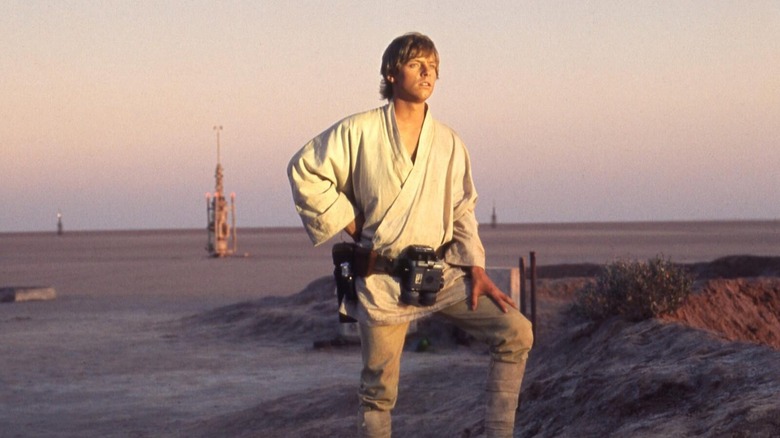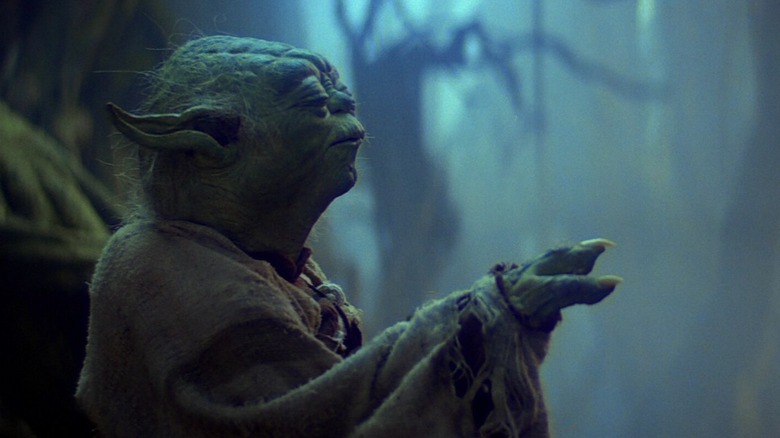George Lucas Took The Silent Movie Approach To Writing The Star Wars Saga
It's been 46 years since George Lucas injected the "Star Wars" virus into the pop cultural bloodstream, and, for those who weren't there from the start, I often wonder if they fully understand why the first film captured moviegoers' imaginations and changed the medium forever.
Though "Star Wars" seems more ubiquitous than ever, it was never sacrosanct in terms of non-canonical spinoffs. After a limited series that retold the story of the first movie, Marvel Comics built out the universe in a run that lasted until 1987. Dark Horse Comics picked up that torch in 1991 and had a ball imagining a post-Original Trilogy universe for decades. The Extended Universe books by Timothy Zahn also filled in blanks you didn't know you needed to fill in.
But until recently, "Star Wars" was, as it had initially been conceived, a big-screen saga. It was mythic. As such, its narrative was all big gestures. Luke Skywalker was the chosen one. The most evil figure in the galaxy wasn't just his sworn enemy, but his father. The princess he rescued in the first film couldn't be his love interest because she was, of course, his sister. His mother? Her death hastened the fascist rule he's been charged with cutting down.
This is big, Greek drama stuff, and it's largely been banished from the franchise. Everything happens within the margins. This doesn't mean it's bad at all (some of it's terrific), but it's small potatoes compared to the sweep of what inspired it. And the inspirational quality of those movies had as much to do with their aesthetic as their narrative.
Films of visual and aural eloquence
When people lined up to see "Star Wars" during its initial theatrical release in 1977 ("Episode IV – A New Hope" would be tacked on later), they'd been promised a transformative experience. There was no better way to wow a crowd than John Williams' fanfare, which has long since overtaken Max Steiner's "Gone with the Wind" theme as the most iconic piece of film scoring in the medium's history.
Williams' music is integral to the primal impact of the OT movies, but he was only responding to what Lucas had given him visually. And this was by design because Lucas, a visual storyteller who vibes on music (see "American Graffiti"), writes with images and the score in mind. As he told Laurent Bouzereau and Jody Duncan in their book "Star Wars: The Making of Episode I – The Phantom Menace:"
"When I write the script ... I hear the movie more in terms of music than I do in terms of sound effects. I can actually hear it in my mind. I pay a lot of attention to the music, even during the early stages of writing. The 'Star Wars' movies are, in essence, silent movies because they are stories that are told visually; and in silent movies the relationship between image and music is everything. A lot of the story and a lot of the emotion are told through the music. It is one of the most important elements of a film."
A visual medium no longer
Regardless of how you feel about the Prequel Trilogy, you cannot deny their visual and aural majesty. In the early days of DVD, films were occasionally released with an isolated music track (e.g. Neil Jordan's "End of the Affair," which, given that it's based on Graham Greene's masterful novel, works perfectly fine with the dialogue left in). I've got a feeling the story of Anakin Skywalker's corruption and ultimate ruin might benefit from this option.
Lucas was never an expert with words, but, my God, the man could fire our imaginations with an Empire Star Destroyer drifting ominously across the frame or the solitary shot of a restless young man, eager to break free of his desert-planet prison, watching two suns set tauntingly in the distance. And what about a shriveled, diminutive green Jedi lifting an X-wing fighter out of a swamp? Somehow, Williams knew exactly what that sounded like. And almost 50 years later, these are the shots that we keep going back to.
Lucas made movies during an era when you wouldn't dare take your eyes off the screen. Today's storytellers have to build in the viewer's disinterest as a given. It ain't wrong and it ain't right. It just is.


